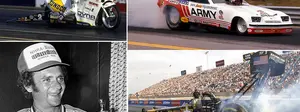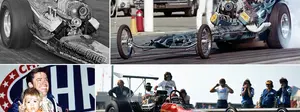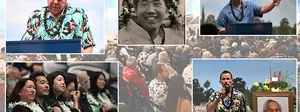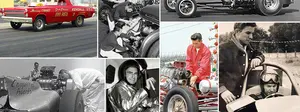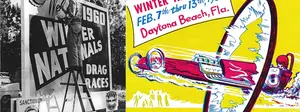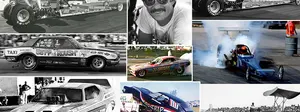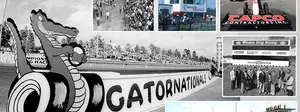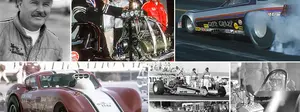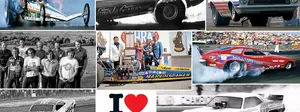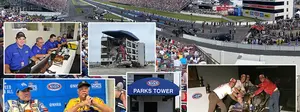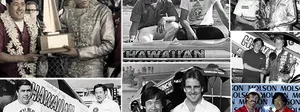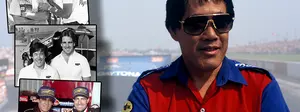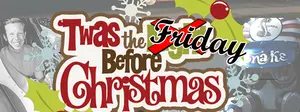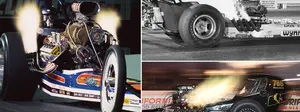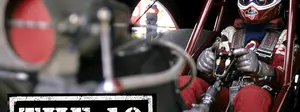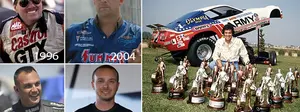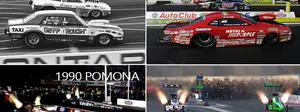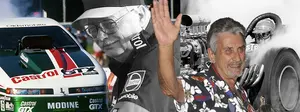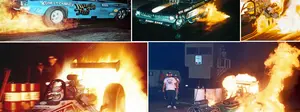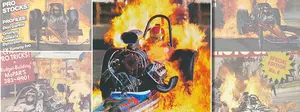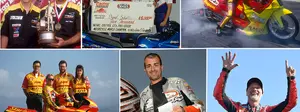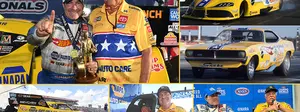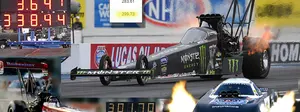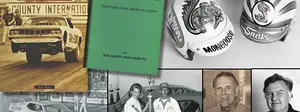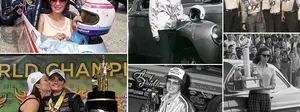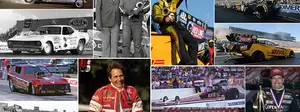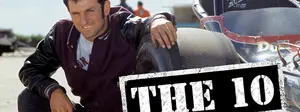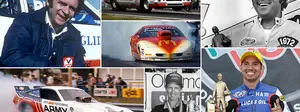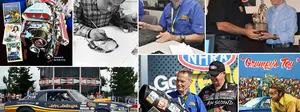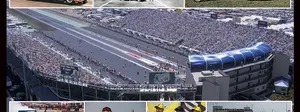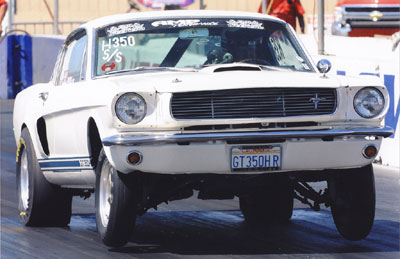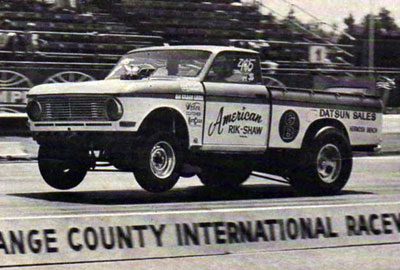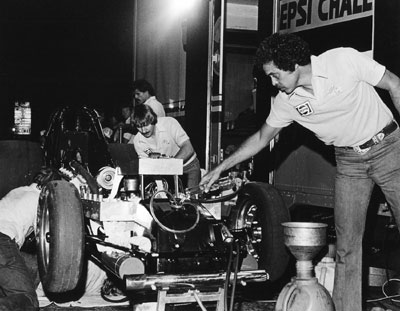OCIR Week: Your turn
 |
Apparently, OCIR Week is that special kind of week that contains more than seven days. My Inbox has been flooded the last several days with heartfelt thanks and heartwarming memories from those who had the opportunity to race or spectate at Orange County Int’l Raceway. Though I'm sure that all racers and fans would feel the same way about the loss of the local quarter-mile on which they cut their teeth, for some reason, OCIR fans have always been a little more vocal. I'd hesitate to call them the most vocal because I know that those who attended Lions still consider it a semireligious experience, but there's no disputing the love still heaped on OCIR 25 years after her demise. Thus, consider today an extension of OCIR Week … this time from your side, with your words and photos.
Quite a few of you told me that you learned things you never knew about the old gal and wanted to know where I got my information. There are several very good Web sites with information on the track's history, and I was lucky to find in our files two pristine copies of the original (and very thick) press kit handed out at the press conference Nov. 10, 1966 – I wonder what those would be worth at a memorabilia show. I also drew from our own thorough coverage of the track in those final years as well as an interview we did with Mike Jones in 1995 for a Where Are They Now? feature in National DRAGSTER. Add to that good relationships with former OCIR personnel such as Charlie Allen, Larry Sutton, Pat Green, and Howard Hull (whose remembrances are below), and I almost had too much info.
But on to your memories …
Having too much info can be a bad thing because you have to weigh what to include and what not to so that your column does not become a never-ending tale, but I was glad that I included the bracket winners who raced long into the early hours of Sunday. Perhaps the single most gratifying piece of correspondence I received was from a guy you had probably never heard of: Randy Gillis. Gillis was the Bracket 3 winner that night and wrote to thank me for including his name in the story. I told him that the pleasure was all mine because – at least for me – that's part of the motivation of including those details. Sure, you want to have the info in there for history's sake, but whenever I mention some obscure name, the small hope is always there that the person will actually read his or her name or be told about it and know that his or her glory lives on, even in some small fashion.
|
"OCIR was my home for all 21 years," wrote Gillis. "Any day the track was open, I was there racing. That track was magical. I had every race car I owned there that night in various brackets and was lucky enough to win Bracket 3 with the one I drove. I still bracket race the same '66 GT350
The '40 Willys pickup of Tietz & McCullough was a familiar bracket vehicle to anyone who went to OCIR in the '70s and '80s, and Billy McCullough also took the time to remember OCIR. "I can remember racing 'the County' on Saturday night and then going to Irwindale on Sundays; those were the days. I couldn't help but think of all the times we raced there and I waved up to Ester Padron (Albert's wife) and how she would write 'You Turkey' on my time slip when I would red-light. I remember how after Irwindale closed we went down and became part of the family at OCIR with the likes of the Marcums, Carl Smith, Rick Abood, and many more. Those were great memories; thanks for bringing them back!"
|
Reagan Williams, whose family owned the crowd-pleasing American Rik-shaw Datsun truck, remembered, "I learned how to drive a stick-shift car in the $1-a-lap Subarus that someone put there on the motocross track. I raced my first car there, a brown '62 Chevy that I had bought for $100 with a transmission that slipped badly in 2nd gear. The photo of the OC tower with broken-out windows almost brought me to tears. My brother has the giant blue OCIR sign that was displayed for years on the side of the 5 freeway. He has it on display every day in his shop while he works on today's Funny Cars at Victory Race Cars in
Charlie Arford shared an e-mail to his family and friends in which he encouraged them to read my OCIR series. Arford couldn’t make the last race as he and his wife were expecting their first and only child, Cory, at any moment.
He wrote, "If I came upon a genie in a bottle and had three wishes, the first wish would be to hold my late wife in my arms and dance with her one more time. My second wish would be for my bank account to always have money in it so no matter what the amount of the check was or every time I use my ATM card, there would always be money to cover that expense. The third wish would be to race at OCIR one more time. Reading these articles and looking at the pictures knowing that I was somewhere in the crowd and for that one single moment in time frozen forever on film, life was so good and that it couldn’t get any better, I could have died right there on the spot, and I would have felt as though my life was complete.
"I think I sat in my backyard all afternoon and well into the evening listening to the faint sounds of burnouts and full pulls being made, which conjured up images from my past races and visits to OCIR. All I could do that day was just sit, listen, and imagine what it must have been like to be there on that final day of her life. I’m going to stop now because I have tears rolling down my face, and that doesn’t look good here at work."
|
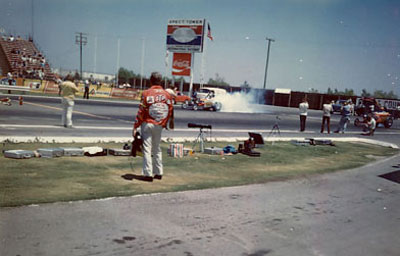 |
He wasn't the only one moved to tears. Wrote Charles Weeks, "I’m sitting at my desk crying, thinking of all the good times my dad and I had at OCIR. We all loved Lions, Irwindale,
One recurring theme was how kids used to be dropped off at the track by their parents to spend a day alone taking in the sights and sounds. Those were simpler times, of course.
George Adams, who today is Woodburn Dragstrip’s (Ore.) track photographer and races in Top Dragster, remembered, "I was one of the many who had a chance to grow up there. From 1967 to 1971, I would go as often as I could, and in saving my allowance, I could go twice a month. We lived in
Leonard Hammond has similar memories. "My first drag race was at Lions, and it was a special place for me," he wrote. "I only went to Irwindale a couple of times and really didn’t care for it, but OCIR was my favorite track. Back in the '70s, I lived in the
Wrote Cliff Short, "I spent many weekends at 'the County' in the early '70s, all the way till the end. As a teenager in the '70s, I went almost every weekend. I got to know many of the regular bracket racers, who taught me a lot about building, tuning, and, yes, even racing the cars. My two biggest heroes of the bracket wars were the White brothers, Steve and Terry. I was fortunate enough when I got into high school to get to race a couple of different vehicles at OCIR. I may not have been running nitro, but I sure felt the thrill of going down that famed 1,320! Just knowing that all the big names of the sport laid down rubber that I was racing on gave me goosebumps (even now as I write this)! Whether it was OCIR, Lions, Irwindale, or another track, it kept me, and a lot of other kids, out of trouble. It was my anti-drug! Oh, by the way, I have the sign that read '
Howard Lloyd, who lives in
|
Kevin Aardahl (bet he was always first in roll call at school!) grew up in Pasadena and made regular treks down to OCIR with a couple of friends in his dad's '69 Datsun 510 for the infamous Fox Hunts during the track's rowdy late 1970s. "Back then, OCIR was practically on the edge of the earth as far as we knew it," he remembered. "Anyway, my one buddy said he was going to sneak in through the fence at the end of the track by way of the orange or avocado groves. My other friend and I paid for tickets and waited in a long line of rowdy people to get in the track. They were searching everybody, and the line was real long. A bunch of folks scaled the tall chain-link fence and started swinging back and forth. In a short amount of time, the entire fence fell forward, and everyone ran in. We showed the guy our tickets at the now fallen gate; he looked at us, held up his hands, said sorry, and we went on to find a seat (along with a hundred or so that didn't pay). We eventually caught up to our buddy that made it in free via the fields and a hole in the fence. As the night progressed, we got a taste of the rowdy OC bikini-clad gals. The night was finally called when a few girls went down along the north side of the track, lifted their tops and/or dropped their shorts. I live in Rancho Santa Margarita now and drive through that area from time to time. When I drive by the old
Vic Deverian knows the feeling. "My dad would take me there for a big Saturday night race starting when I was around 13 (1973)," he said. "It was a sad day when they closed that strip. To this day, when I'm on the 5 south, I'll glance over where the strip used to be."
|
Bill Gathings wrote, "I was at the last race at OCIR. Despite the reassurances over the PA during the night that 'at least two or three sites were being looked at for a new track and that the tower would be saved and reused,' etc., we just knew somehow that this was the end of an era in the Southland. I remember the pits were full, a number of cars were up for sale, and the whole thing being run like they were in slow motion, as if they wanted to end as late as possible. A long, sad night."
Lee Littlefield, wife of Funny Car racer Mert and mother of our own Associate Editor Brad (who, she notes, was born two months after the Last Drag Race, so he was there, too), remembers most fondly the people she met who became lifetime friends. "OCIR was so close, we could sleep in our own bed at night, but mostly it was the friends we made. Vicki Gasparrelli, Carol Anderson, Cindy Allen, Dianne Dunn, and Geri Amato stand out in my mind. Great women. I told Brad my Joe Pisano story; Joe was not the grumpy man that everyone thought he was … he was a big teddy bear in my eyes."
Jeff Thomas also counts himself as lucky to have been at the final event. "Your story brought back many wonderful memories and tears, as I was fortunate to be there that night," he wrote. "I came up from
Not everyone was so lucky. Jeff Kempton, who lives in
The great thing about sharing tales isn't necessarily the details of what car it was or who was driving or what the date was but the memories themselves to which we can all relate. Gerrett Wikoff, who used to bracket race his '65 VW Bug at OCIR and Irwindale, wrote, "My all-time favorite Top Fuel drag race occurred at OCIR. I don't recall who was running, but he blew up in the lights in the semi's but got the win light. They thrashed away - borrowing parts, blowers, pistons, you name it - wrenching at light speed, and barely made the final call. The other car started, went into the bleach box and burned out with a big smoky burnout and was backing up … but his competition? The starter was a no-go. The car would not fire. Guys were running around like crazy as the running car staged -- first one stage light, then the second. The starter, raising his hands to push the go button, looked over at the dead dragster as a pickup truck careened up to it and did an old-school push-start! The car lit the pipes, hauled ass down the staging lanes, and hung a fast U-turn into the bleach box, nailed the nitro for a short hop up into the staging beams. Staged. Bam! Down come the lights, he nails the gas and beats the other rail to the stripe and wins the meet!"
 |
Hull, a frequent contributor to the Insider, started parking cars at OCIR as a teen in the 1960s and worked his way into selling Cokes in the stands so he could watch the races better and eventually ended up working with Lynn Rose and Charlie Allen toward the end in 1983.
“Let's go see the raceway! That was my introduction to what would become the beginning of a love affair with drag racing. My mom and dad, along with Larry Vaughan, drove out to
"The first drag race I ever saw was the inaugural race at
"It was a wild night of weird sounds, smells, and sights as we watched the cars race down the track. I remember watching the cars launch from the Christmas Tree with each set of bulbs with the half-second intervals; the handicapping was really fun as the lights would blink down at different rates. I remember one race quite clearly when they sent a station wagon against a rail dragster, which really sent the crowd cheering when the rail reeled in the station wagon and his win light came on at the end of the track.
"It was several years later in the early 1970s that I was allowed to go to work at OCIR on the major races. I would do whatever I could to keep out of trouble and be helpful. My first paying job was hawking Cokes in the stands in the afternoon. I would get in early with Larry and get the track set, and around 1 p.m., I would start hawking Cokes in the stands until around 7 p.m., when it got too crazy. Cokes were 25 cents back then, and I could make a good $15 to $20 in the afternoon and then go and watch the races in the evening. During this time, I was meeting racers such as 'the Mongoose' and 'the Snake,' Gary Cochran, Gary Gabelich (who went on to set the Bonneville record in the Blue Flame), John Collins, James Warren, Tony Nancy, Rich Siroonian, Billy Meyer, the Beebe brothers, Don Schumacher, and more.
"The track had a series of races that were called the All Star Race Series. We held an All Star race on New Year's Eve, and Don Prudhomme won that race driving his new rear-engine dragster. Earlier that afternoon, his wing left the car at the finish line and flew up into the air and landed by me. I thought that I had gotten the coolest souvenir! That lasted about five minutes till I was told that he wanted it back! That’s okay; he did give me my Mattel Hot Wheels 'Snake' and 'Mongoose' cars.
"The rear wings were cool to see on top of the fuelers. I remember one of the Marine aviators stationed at neighboring El Toro Air Station discussing the fact that the drivers need to flip the wing over to get the thing to work (lift over the longer surface). It was funny watching the look on their faces when I drew the example on a piece of paper for them to see what he was trying to explain to them as a 13-year-old.
"OCIR was a great place to grow up for the most part. When the Top Fuelers, Funny Cars, and fuel altereds ran, I would stand along the fence watching them come flying down the track at me with the flames coming out the headers. The loudspeaker would be right above us, and you would hear the launch first over the speaker, and then with the delay due to the distance, the sound would catch up.
|
"The track had a road course as part of the return road back into the pits, which was used for karting and other training. The
"It wasn’t until the mid-1970s when Bill Doner took over the track that it really became fun, for several reasons. One, I could drive to work in my 1972 Buick Skylark, and, two, I got to really know the racers better from the management side, too. Raymond Beadle, Lil' John Lombardo, Johnny Loper. I remember Kenny Bernstein learning to drive his Chelsea King Funny Car at the expense of OCIR’s guardrails. As he learned to steer it, he bounced a few times. I would go out and replace what was bent and twisted beyond repair. After a very successful afternoon of qualifying for one of our evening races, he walked into Doner’s office and announced: “OCIR 12, Bernstein 1.”
"John Force? Now that was fun. Here was a guy who really loved what he was doing and was a real firebrand back then. Many times I would be at the top-end turnout with the crash crew when he came in either dripping oil, on fire, parts hanging on by a string, Okay, many times all of the above. Yet, as he developed as a racer and learned how to run the car, it was fun. Steve Plueger was the crew chief, and we had some fun with John. There were times where Doner wouldn’t want John to run as he was always leaking on the damn track. The debate would go on and on, and, in the end, Doner decided he could continue to race there. Besides, when John would be running, the fans would all run to watch to see if he was either going to blow up or catch on fire or both!
"Doner was the P.T. Barnum of drag racing, and I really learned a great deal from him about the promotion side of racing. We would have the 'Grand Kinko' races, as he would call them. Local Funny Cars, wheelstanders, jet cars, rocket cars, and fireworks. Once a month, we would have a big race. The summer evenings were the best as I could climb to the top of the timing tower and watch the cars streaming in, and to the east was El Toro Marine Air Station. I could watch the planes take off and land as the sun slowly set into the hills to the west, and we would start up the event with the national anthem and then hit the starter motors and go racing."
Okay, race fans, that officially wraps up OCIR Week And A Half. Thanks for all your remembrances, photos, and inspiration. I'll see you later this week.


